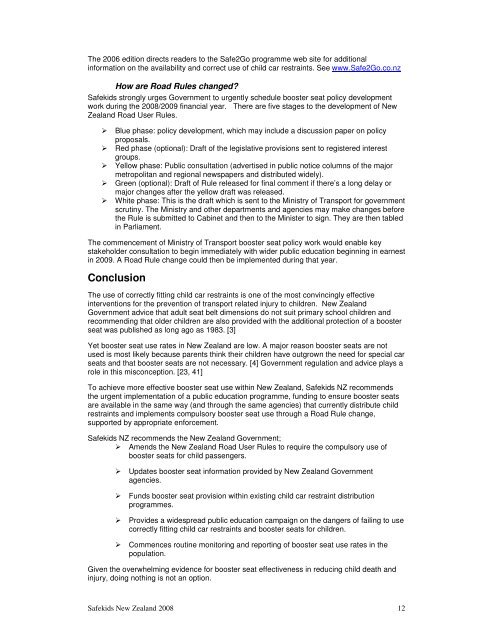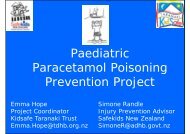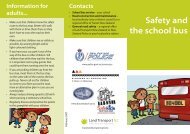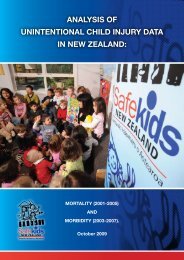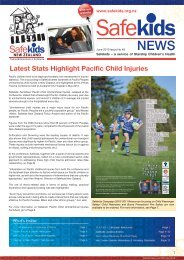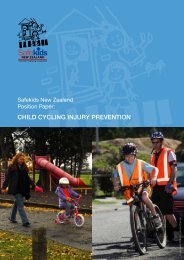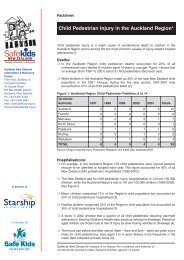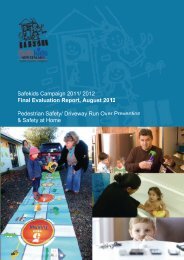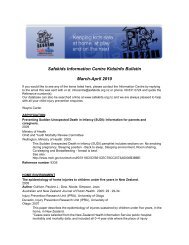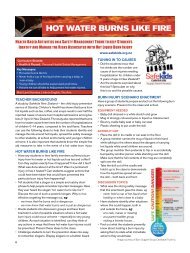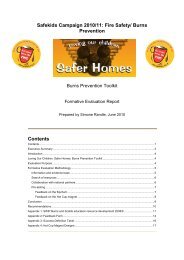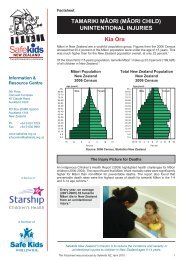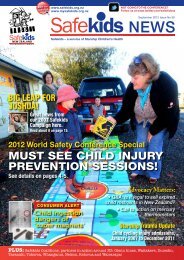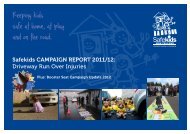Summary It's booster seat time for Kiwi kids - Safekids
Summary It's booster seat time for Kiwi kids - Safekids
Summary It's booster seat time for Kiwi kids - Safekids
Create successful ePaper yourself
Turn your PDF publications into a flip-book with our unique Google optimized e-Paper software.
The 2006 edition directs readers to the Safe2Go programme web site <strong>for</strong> additional<br />
in<strong>for</strong>mation on the availability and correct use of child car restraints. See www.Safe2Go.co.nz<br />
How are Road Rules changed?<br />
Safe<strong>kids</strong> strongly urges Government to urgently schedule <strong>booster</strong> <strong>seat</strong> policy development<br />
work during the 2008/2009 financial year. There are five stages to the development of New<br />
Zealand Road User Rules.<br />
Blue phase: policy development, which may include a discussion paper on policy<br />
proposals.<br />
Red phase (optional): Draft of the legislative provisions sent to registered interest<br />
groups.<br />
Yellow phase: Public consultation (advertised in public notice columns of the major<br />
metropolitan and regional newspapers and distributed widely).<br />
Green (optional): Draft of Rule released <strong>for</strong> final comment if there’s a long delay or<br />
major changes after the yellow draft was released.<br />
White phase: This is the draft which is sent to the Ministry of Transport <strong>for</strong> government<br />
scrutiny. The Ministry and other departments and agencies may make changes be<strong>for</strong>e<br />
the Rule is submitted to Cabinet and then to the Minister to sign. They are then tabled<br />
in Parliament.<br />
The commencement of Ministry of Transport <strong>booster</strong> <strong>seat</strong> policy work would enable key<br />
stakeholder consultation to begin immediately with wider public education beginning in earnest<br />
in 2009. A Road Rule change could then be implemented during that year.<br />
Conclusion<br />
The use of correctly fitting child car restraints is one of the most convincingly effective<br />
interventions <strong>for</strong> the prevention of transport related injury to children. New Zealand<br />
Government advice that adult <strong>seat</strong> belt dimensions do not suit primary school children and<br />
recommending that older children are also provided with the additional protection of a <strong>booster</strong><br />
<strong>seat</strong> was published as long ago as 1983. [3]<br />
Yet <strong>booster</strong> <strong>seat</strong> use rates in New Zealand are low. A major reason <strong>booster</strong> <strong>seat</strong>s are not<br />
used is most likely because parents think their children have outgrown the need <strong>for</strong> special car<br />
<strong>seat</strong>s and that <strong>booster</strong> <strong>seat</strong>s are not necessary. [4] Government regulation and advice plays a<br />
role in this misconception. [23, 41]<br />
To achieve more effective <strong>booster</strong> <strong>seat</strong> use within New Zealand, Safe<strong>kids</strong> NZ recommends<br />
the urgent implementation of a public education programme, funding to ensure <strong>booster</strong> <strong>seat</strong>s<br />
are available in the same way (and through the same agencies) that currently distribute child<br />
restraints and implements compulsory <strong>booster</strong> <strong>seat</strong> use through a Road Rule change,<br />
supported by appropriate en<strong>for</strong>cement.<br />
Safe<strong>kids</strong> NZ recommends the New Zealand Government;<br />
Amends the New Zealand Road User Rules to require the compulsory use of<br />
<strong>booster</strong> <strong>seat</strong>s <strong>for</strong> child passengers.<br />
Updates <strong>booster</strong> <strong>seat</strong> in<strong>for</strong>mation provided by New Zealand Government<br />
agencies.<br />
Funds <strong>booster</strong> <strong>seat</strong> provision within existing child car restraint distribution<br />
programmes.<br />
Provides a widespread public education campaign on the dangers of failing to use<br />
correctly fitting child car restraints and <strong>booster</strong> <strong>seat</strong>s <strong>for</strong> children.<br />
Commences routine monitoring and reporting of <strong>booster</strong> <strong>seat</strong> use rates in the<br />
population.<br />
Given the overwhelming evidence <strong>for</strong> <strong>booster</strong> <strong>seat</strong> effectiveness in reducing child death and<br />
injury, doing nothing is not an option.<br />
Safe<strong>kids</strong> New Zealand 2008 12


